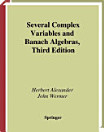Potential Theory
Jun 2013 · Springer Science & Business Media
eBook
149
Halaman
reportRating dan ulasan tidak diverifikasi Pelajari Lebih Lanjut
Tentang eBook ini
Potential theory grew out of mathematical physics, in particular out of the theory of gravitation and the theory of electrostatics. Mathematical physicists such as Poisson and Green introduced some of the central ideas of the subject. A mathematician with a general knowledge of analysis may find it useful to begin his study of classical potential theory by looking at its physical origins. Sections 2, 5 and 6 of these Notes give in part heuristic arguments based on physical considerations. These heuristic arguments suggest mathematical theorems and provide the mathematician with the problem of finding the proper hypotheses and mathematical proofs. These Notes are based on a one-semester course given by the author at Brown University in 1971. On the part of the reader, they assume a knowledge of Real Function Theory to the extent of a first year graduate course. In addition some elementary facts regarding harmonic functions are aS$umed as known. For convenience we have listed these facts in the Appendix. Some notation is also explained there. Essentially all the proofs we give in the Notes are for Euclidean 3-space R3 and Newtonian potentials ~.
Beri rating eBook ini
Sampaikan pendapat Anda.
Informasi bacaan
Smartphone dan tablet
Instal aplikasi Google Play Buku untuk Android dan iPad/iPhone. Aplikasi akan disinkronkan secara otomatis dengan akun Anda dan dapat diakses secara online maupun offline di mana saja.
Laptop dan komputer
Anda dapat mendengarkan buku audio yang dibeli di Google Play menggunakan browser web komputer.
eReader dan perangkat lainnya
Untuk membaca di perangkat e-ink seperti Kobo eReaders, Anda perlu mendownload file dan mentransfernya ke perangkat Anda. Ikuti petunjuk Pusat bantuan yang mendetail untuk mentransfer file ke eReaders yang didukung.





